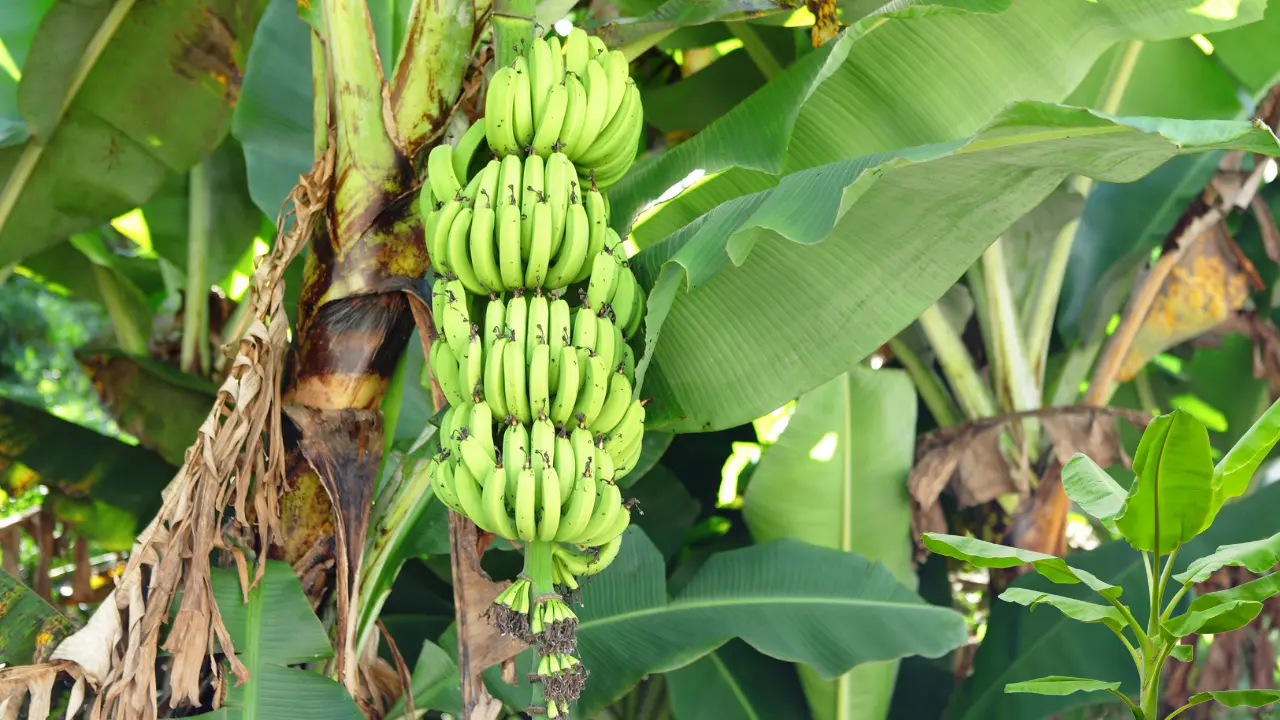Picture this: a warm Florida morning, and you’re stepping outside to pick your own fresh, ripe bananas. Sounds amazing, right? Growing your own bananas is easier than you might think, especially when you consider the sunshine we get here in the Sunshine State! This post is all about the best banana trees to grow in Florida, so you can enjoy this tropical treat from your own backyard. We’ll explore the top varieties, how to take care of them, and everything else you need to know. Get ready to transform your garden and taste the difference of home-grown goodness! You’ll learn which banana trees thrive here, giving you the skills to cultivate your own banana bounty.
Key Takeaways
- Learn about the top banana tree varieties suited for Florida’s climate.
- Discover essential care tips, including sunlight, watering, and soil requirements.
- Find out how to protect your banana trees from pests and diseases common in Florida.
- Understand the best practices for harvesting and enjoying your home-grown bananas.
- Get expert advice on choosing the perfect spot to plant your banana tree.
- Gain confidence to start your own banana patch.
The 10 Top Banana Tree Varieties for Florida Gardens
Florida’s warm and humid climate creates a perfect environment for growing banana trees. While many varieties can flourish here, some are better suited to our specific conditions than others. This comprehensive guide will help you select the ideal banana trees for your garden, considering factors like cold hardiness, fruit quality, and overall ease of cultivation. From the classic Cavendish to more unique cultivars, we will explore the best options for bringing the taste of the tropics to your own backyard. Get ready to explore the exciting options and start your own banana growing adventure!

1. Cavendish Banana (Musa acuminata ‘Cavendish’)
The Cavendish banana is likely the most familiar variety, being the most common type found in grocery stores. These plants are widely grown because they are relatively easy to cultivate and produce large bunches of fruit. While they can grow well in Florida, they are somewhat susceptible to Panama disease. They require consistent care and protection from cold snaps, especially in northern Florida. With proper care, they can still be a rewarding choice for home gardeners, offering familiar, sweet flavor.
Key Features
- The fruit is sweet and easily peeled, perfect for eating fresh.
- It can grow to a height of 8-10 feet in ideal conditions.
- Requires well-draining soil and regular watering.
2. Dwarf Cavendish (Musa acuminata ‘Dwarf Cavendish’)
If you’re looking for a banana tree that’s a bit more compact, the Dwarf Cavendish is an excellent option. It grows to a more manageable height, typically around 6-8 feet, making it a great choice for smaller yards or container gardening. This variety offers all the benefits of the regular Cavendish banana, including a delicious flavor, but in a more space-friendly package. Its size makes it easier to protect from harsh weather conditions and move if necessary. It is a popular option.
Considerations
- Suitable for containers.
- Requires less space.
- Grows well in partial shade.
3. Ice Cream Banana (Musa × paradisiaca ‘Ice Cream’)
Also known as Blue Java bananas, the Ice Cream banana is celebrated for its unique flavor, which is often compared to vanilla ice cream. This variety is known for its cold tolerance compared to other banana varieties. The fruits have a creamy texture and are incredibly delicious. They are slightly blue when unripe, turning yellow when ready to eat. This variety is very popular.
Growing Tips
- Needs full sun for best fruit production.
- Requires consistent watering, especially during dry periods.
- Prune off dead leaves to promote airflow and prevent disease.
4. Gros Michel Banana (Musa acuminata ‘Gros Michel’)
The Gros Michel is a classic banana, known for its sweet flavor and distinct aroma. While not as commonly found as the Cavendish today due to susceptibility to Panama disease, it’s still a good choice for Florida gardens. Its flavor is considered by many to be superior to the Cavendish. It is very cold-sensitive. The plants grow tall. These trees are best planted in a location that protects them from strong winds. Proper care will ensure a harvest of flavorful bananas.
Cultivation Tips
- Needs protection from strong winds.
- Requires rich, fertile soil.
- Good drainage is crucial to avoid root rot.
5. Rajapuri Banana (Musa × paradisiaca ‘Rajapuri’)
The Rajapuri banana is known for its excellent taste and productivity. This variety is moderately cold-hardy, doing well in many parts of Florida. The fruit is sweet and has a slightly tangy flavor, making it a favorite for fresh eating and cooking. The trees are very productive, and they are capable of producing several bunches of bananas each season. They provide a bountiful harvest, making it a worthwhile addition to your garden.
Characteristics
- The fruit is delicious and versatile.
- These trees are relatively resistant to disease.
- Requires regular fertilization to support fruit production.
6. Williams Hybrid Banana (Musa acuminata ‘Williams Hybrid’)
Williams Hybrid is another Cavendish type, known for its high yield and adaptability. It has a slightly sweeter flavor. This variety is often favored by commercial growers. They have the same need for regular watering. They are cold-sensitive, but they can be grown with proper care. These trees perform well in Florida’s climate. This makes it a great choice for home gardens, providing a bountiful harvest of delicious fruit. This cultivar offers a balance of taste, production, and relatively ease of care.
Growing Requirements
- Needs ample sunlight.
- Requires regular pruning to remove dead or diseased leaves.
- Provide shelter from strong winds.
7. Goldfinger Banana (Musa × paradisiaca ‘Goldfinger’)
Goldfinger is a hybrid banana known for its resistance to Panama disease and its delicious flavor. It has a slightly citrusy flavor. This variety is great for areas where disease is a concern. The fruit is firm and holds its shape well. This makes it a good option for cooking as well as fresh eating. It offers a combination of disease resistance, excellent flavor, and general adaptability to different conditions. It’s also known for being a relatively easy banana to grow.
Special Considerations
- Resistant to Panama disease.
- Good for cooking and fresh eating.
- Requires regular fertilization.
8. Manzano Banana (Musa acuminata × balbisiana ‘Manzano’)
The Manzano banana, also called the Apple banana, has a unique flavor reminiscent of apples and strawberries. It is a smaller banana, making it a great option for smaller spaces. They are known for being cold-hardy, compared to other varieties. This variety produces sweet fruit with a slight tang. The fruits are shorter and fatter than some other varieties. Manzano bananas can be enjoyed raw or used in various culinary applications.
Cultivation Tips
- Prefers partial shade.
- Requires consistent moisture.
- Fruits best in well-draining soil.
9. Praying Hands Banana (Musa × paradisiaca ‘Praying Hands’)
The Praying Hands banana is a unique cultivar. The fruits grow in fused bunches that resemble a pair of hands clasped in prayer. The taste is sweet. This makes it a visually interesting and delicious choice. They are known for their distinctive appearance. Praying Hands bananas provide an interesting and unique element to your garden. They offer both visual appeal and a flavorful eating experience.
Unique Features
- Unusual appearance.
- Has a sweet flavor.
- Requires regular watering.
10. Bluggoe Banana (Musa × paradisiaca ‘Bluggoe’)
The Bluggoe banana is a cooking banana, great for those interested in adding variety to their culinary practices. It is less sweet. It has a starchy texture, often used in cooking. It is a good option for making chips or adding to stews. The Bluggoe banana offers a unique flavor profile compared to dessert bananas. They grow to a medium height, making them manageable for home gardens. This variety adds versatility to your banana patch.
Useful Information
- Often used for cooking.
- Resistant to cold weather.
- Requires a sunny location.
Common Myths Debunked
Myth 1: Banana Trees Only Grow in Tropical Climates
While bananas thrive in tropical climates, some varieties are adapted to grow in subtropical areas like Florida. The selection of the right cultivar is the key. Proper care, including protection from cold snaps, allows home gardeners to enjoy fresh bananas.
Myth 2: Banana Trees Are Difficult to Grow
Banana trees can be relatively easy to grow. They are hardy. The key is choosing the right variety for your area and providing adequate care. This includes providing sufficient sunlight, regular watering, and protection from pests. Once established, they require little effort.
Myth 3: All Bananas Taste the Same
There are numerous banana varieties, each with its own flavor profile. From the sweet Cavendish to the vanilla-flavored Ice Cream banana and the apple-like Manzano, the taste experience varies. Growing different varieties expands your palate and enjoyment of bananas.
Myth 4: Banana Trees Need Constant Watering
Banana trees require regular watering, but the frequency depends on the climate and soil type. Overwatering can lead to root rot. Well-draining soil is essential. Adjust watering practices based on environmental conditions and the needs of the tree.
Myth 5: Banana Trees Only Produce Fruit Once
Banana trees produce fruit only once, but they also produce “pups” or offshoots. The main stalk will die after fruiting. The pups will grow and bear fruit, continuing the cycle. This allows for a continuous banana harvest from your tree.
Frequently Asked Questions
Question: How much sunlight do banana trees need?
Answer: Banana trees need at least 6-8 hours of direct sunlight daily for the best fruit production. Some varieties can tolerate partial shade, but full sun is generally preferred.
Question: How often should I water my banana tree?
Answer: Water your banana tree deeply and regularly, especially during dry periods. The frequency depends on your local climate, soil type, and the age of the tree. Check the soil moisture and water when the top inch of soil feels dry.
Question: How do I protect my banana tree from cold weather?
Answer: Protect your banana tree during cold snaps by wrapping the trunk with burlap or cloth, mulching around the base to insulate the roots, and covering the leaves with a blanket or tarp. For container-grown trees, move them indoors or to a sheltered location.
Question: What kind of soil is best for banana trees?
Answer: Banana trees grow best in rich, well-draining soil with plenty of organic matter. Amend your soil with compost or well-rotted manure to improve drainage and provide essential nutrients.
Question: When and how do I harvest bananas?
Answer: Harvest bananas when the fruits are plump and the edges of the banana bunch are beginning to turn yellow. Cut the entire bunch from the tree, leaving some of the stalk attached. You can allow bananas to ripen further at room temperature.
Final Thoughts
Bringing the taste of the tropics to your Florida garden is very possible, thanks to the range of best banana trees to grow in florida. From the well-known Cavendish to unique varieties like Ice Cream and Manzano, there’s a perfect banana tree for everyone. Remember that selecting the right variety for your local conditions is important. Providing your trees with ample sunlight, consistent watering, and protection from the cold will ensure a successful harvest. Don’t be afraid to experiment with different varieties to find your favorites. You may find that growing your own bananas is surprisingly simple. So, why wait? Start your journey to fresh, home-grown bananas today, and you’ll be enjoying the sweet rewards for years to come!
